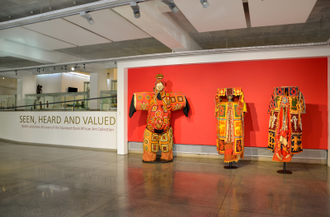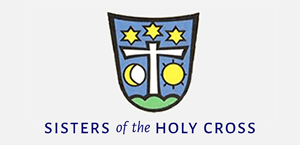South Africa: Seen, Heard and Valued at Witwatersrand Art Museum

Image: Sally Roper
A landmark art exhibition at the University of the Witwatersrand Art Museum (WAM) Johannesburg, celebrates a brilliant indigenous artistic arc: the timely exhibition Seen, Heard and Valued pays tribute to 40 years of indigenous collecting and academic research.
South Africa, despite its post-apartheid troubles, remains a bellwether in terms of a proactive national process focused on redressing the abuses of a troubled past, as shown through its art history.
South Africa's art closely documents the sweeping saga of a fraught national political history spanning 350 years - but also encompassing the precolonial era. The art - from the precolonial cultural and artistic rock art explosion, recording an indigenous culture of great sophistication with a coherency of at least 15,000 years Before Present, to 'the apartheid century' - eloquently displays the society's kaleidoscope of stories.
Until almost the mid-20th century, formal art spaces in South Africa did not even acknowledge the presence of black artists. Shockingly, even a prestige establishment such as the Johannesburg Art Gallery did not own a single work by a black artist until 1940. By the late 1970s, a militant generation of young curators had dumped the bigotry of the past, and turned the spotlight onto neglected artists from black communities, both urban and rural.
In 1979, the multi-national corporation The Standard Bank of South Africa entered into a groundbreaking agreement with the University of the Witwatersrand to provide an annual grant with the remit to collect works by black South Africans, past and present. This landmark award enabled the university to begin to acquire, quite literally, an entire century's worth of indigenous art that was at risk of either mouldering into dust as traditional methods of artistic expression fell away, or disappearing into overseas collections.
However Wits University and Standard Bank were not the only entities ushering in new approaches. In 1985, white curator Ricky Burnett mounted a landmark exhibition, entitled Tributaries, in Johannesburg where a collection of previously unknown black rural artists were shown on an equal basis alongside established urban artists operating in the Fine Art tradition. What was so important about Tributaries was the equality of its premise, and the new artists it profiled. The very title of the exhibition reflected this - i.e. that 'all streams of culture were to be rendered up as tributaries of a strong brown river that is art in South Africa'.
Tributaries had an enormous effect on the art world, as it brought to an urban art public examples of a whole world of rural indigenous creativity that had been overlooked. The works, aside from their technical virtuosity and beauty, often biting social commentary and captivating depiction of the Africa's environment, were also deeply concerned with matters of the spirit, morality, and indigenous paths to interpreting Christianity. Undoubtedly one of the most important of the artists shown at Tributaries was the extraordinary Jackson Hlungwani.
Hlungwani (1923-2010), is known for several key works, one of which, Women's Altar of God (1983-4), forms the centrepiece of this exhibition. Hlungwani, who grew up in the far rural north of South Africa, like many, travelled to Johannesburg to work. After a traumatic event, he returned home, whereafter he joined a quasi-Christian religious sect known as the African Zionist Church. As related by Hlungwani, eventually art and spirituality took over his life, at the direct order of Christ, and after trial by illness unto death. 'At the beginning,' Hlungwani tells us 'I made various daily necessaries [out of wood]. … Now I am almost completely involved in the work that God has set.' Women's Altar, which occupied a woodland clearing near Hlungwani's home, represents a sacred church-like space for worship, and has a slew of intricate mystical references in which African spirituality intertwines with Christianity.
In rural areas, communities frequently had a close relationship with Christian mission stations, as these places were not only often the sole source of basic education, but for many, also the only access to any level of art training. An honourable roll of such missions was involved in nurturing some of the country's most luminous fine art talents, like the magnificent sculptor Job Kekana (1916-1995) who managed to pursue a period of study in London, during which he was able to experience Christian art (his devoted life's work), in a variety of settings, from the work of St Paul's Cathedral's 18th century master carver Grinling Gibbons to Germany's famed Oberammergau passion play. Kekana's exquisite work depicting a wide range of Christian subjects was commissioned for cathedrals and seminaries across Southern Africa up until his death.
This exhibition offers an enchanting array of other insights into African spirituality. A display of carved headrests, a major feature of traditional African life, adorns one wall, each graceful abstract design often also featuring humorous depictions of African wildlife. Once wittily dubbed 'dream machines' by a curator, headrests form a corporeal link between Earth and the ancestors in African tradition as one sleeps. Southern African spirituality holds that one's forebears, though on the other side of the veil between life and death, continue to participate in the earthly realm, and they do so through dreams.
Other transcendental objects in this vibrant display include jewel-like beaded herbal medicine bottles, but also mysterious objects called 'child figures', which are masterpieces of the beader's art. Industrial materials, such as wire, also transform objects like staffs into dazzling examples of the innovation that occurs when new ideas meet tradition.
Featuring an enormous range of mediums - tapestries, photography, basketry and all Fine Art applications - this exhibition is one of the most important of the post-apartheid era. A tribute not only to a band of determined young curators, but also the corporate sponsors whose visionary patronage made this unique collection possible, the last word goes to the famously ebullient Hlungwani, who also spoke about the interconnectedness of nature, humans and spirit. Of his many carvings of fish - also a Christian symbol - he said:
'Fish do go to church, just like ourselves. They are even better in that they praise God every time when the sun sets…. The fish have glorified the Almighty since heaven and earth were created and still are. Therefore we must be like fish.' He adds: 'Fish don't fight!' He was onto something …
The show runs until February 2022.
LINK
Witwatersrand Art Museum (WAM) - www.wits.ac.za/wam/exhibitions/


















